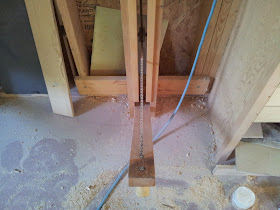My treadle machines are all built around the cast iron flywheel/ freewheel combination found on most exercise bikes. This piece is the heart of the machines it provides the means to input power into the system and stores energy to smooth out the intermittent power of a treadle drive.The freewheel is just like the one on the rear wheel of a bike so you don’t have to time your stroke as you would with a pitman or crank system, also the treadle is not moving on its own using energy better left in the system. The flywheel / freewheel greatly simplifies the construction of these machines as instead of having to build this piece it is just figuring out how to adapt it to the use you want.
Exercise equipment is one of those things that people seem through away regularly (at least in Canada) I have collected many pieces at our local dump as well as friends giving me equipment when they find out that I use it. There are bolts, bushings, tubing, foam, flat stock and many other bits to be used.
Drill Press
The drill press is ideally suited to treadle power because it doesn’t require much power or speed to work effectively. It will drill 1/2" hole in steel, a 1" forstner bit into hardwood and cut 1/2" plugs easily. With its low speed its not efficient when running a sanding drum or other high speed tools.
This is my most used treadle machine. While the design is sound the tool needs a few tweaks.
The drill is built of two vertical ways with a headstock of wood at the top that the metal parts are mounted on. The table slides between the ways and is clamped onto them. At the bottom the treadle pivots on a bolt between the ways. There are two mounting boards screwed onto the back that attach the machine to the wall.
The headstock has a tube with two bronze bushings for the drill shaft to run through. The top of the tube has two ball bearings that the flywheel is attached to, these run on a concentric centre so the shaft can run through them while rotating.
The feed is by a lever attached to the back of the headstock and through a linkage to a piece of tube with a ball bearing in it. The bearing is slipped onto the shaft up against a stop collar. A spring is trapped between the stop collar and the top of the flywheel to provide a return for the shaft.
The drill shaft is a piece of 5/8" keyed shafting that I attached a 1/2" JT-33 (taper) chuck to one end. This was a labourious process of filling the shaft while rotating in two bearings, driving the chuck on, checking for it to be concentric and repeating the process until the chuck would lock on the shaft and run true.
The shaft is driven through a key that is trapped in a 5/8" collar silver soldered to the top of the flywheel (visible above the freewheel in the photo above). So the shaft can move up and down while still having energy transferred to it from the spinning flywheel, a certain amount of slop must be in the system for the shaft to move and rotate at the same time.
The treadle is connected to the freewheel by a piece of chain that runs between the ways and is guided by two inline skate wheels that I turned grooves in to accept the chain. The wheels guild the chain onto the freewheel. Chain only flexes in one direction so a link was made to change the direction of the chain to accommodate the freewheel.
The chain then wraps around the freewheel to a return spring attached to the wall. The chain length, treadle stroke and spring length had to be adjusted so the turning link didn’t run into the freewheel. A crutch tip cushions the treadle impact on the floor.
Operation
So now the operation. First a bit is put into the chuck and the piece to be drilled clamped to the table. Then the treading started , a full stroke and steady rhythm is best. The feed lever is pulled down and the object drilled. As you tread the spring at the top end of the chain is stretched and it pulls up the treadle when you lift your foot for the next tread. The freewheel ratchets and allows the chain to return around it. While this is happening the flywheel is still turning the bit in the work ( though losing energy )until you tread down and energize the system again. The flywheel is approximately 13" in diameter and weighs about 15 pounds. I had thought that this might be to small so made provisions to add another flywheel to it, this has never been needed. There is enough power to spin the bit in the chuck or rip a piece from your hands if the bit locks in the work.
This tool was made with what was in the shop at the time and adapted to the materials at hand. The biggest expense was the chuck (a cheap import $20 I think) and the shafting. If I were to do it again I think I would adapt a commercial drill press to treadle drive and would certainly try it if one came along for the right price (free).
Things to change, the table needs a simpler lockup and there is a tight spot in the rotation probably due to concentric problems but overall not a bad tool.
James





